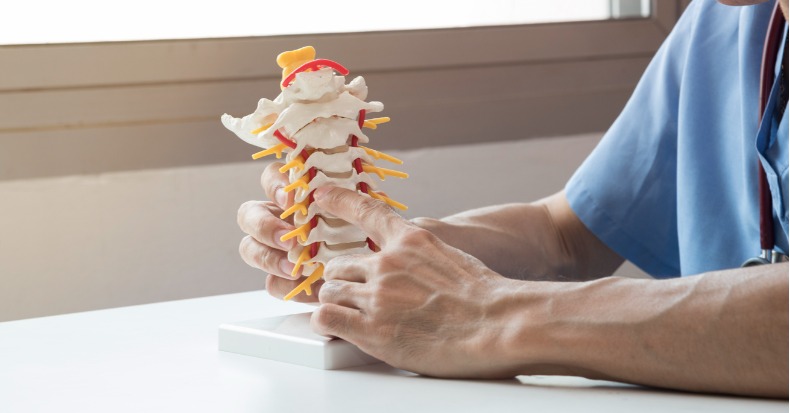Neck pain can arise from many sources. There are ligaments that hold bones to other bones that are non-elastic and very strong. When injured, the term, “sprain” is applied. The muscle and/or its attachment (the tendon) can tear as well, which is called a “strain.” But, what is it that people refer to when they say, “…I slipped a disk in my neck!”?
The disks lay between the vertebrae in the front of the spine, and they are part of the primary support and shock absorbing system of our neck and back. There are 6 disks in the neck, 12 in the mid-back and 5 in the low back for a total of 23. The disks in the low back are big, like the vertebral bodies they lie between, and get progressively smaller as they go up the spine towards the head. When we bend our neck forwards, the disk compresses, and opens wider when we look up. It forms a wedge shape when we side bend left or right, and it twists when we rotate or turn the head.
The terms, “…a slipped disk, a herniated disk, a ruptured disk, a bulging disk” (and more), all mean something similar, if not exactly the same thing. A central part of the disk is liquid-like and can herniate in any direction. When it does, it can create pain IF it pinches something, or it may be painless if it doesn’t. In fact, since the invention of the CAT scan and MRI, many (“normal”) people have been found on the scan to have some type of disk “derangement” (alteration of the normal integrity of the disk), with 50%+ showing bulging disk(s) and 21% showing frank herniations WITH NO PAIN AT ALL! So, in the absence of shooting pain down an arm from the neck, or when there is no numbness or weakness in the arm, why order an MRI? It may show bulges or herniations that are not “clinically” important, and may falsely lead a doctor to recommend surgery when it’s not needed.
There are “KEY” findings in the history and examination that leads us to the diagnosis of a cervical disk injury. From the history, the disk patient often has arm pain, numbness, and/or muscle weakness that follows a specific pathway, such as numbness to the thumb/index finger (C6 nerve), middle of the hand & 3rd finger (C7) or to the pinky & ring finger (C8). Certain positions, such as looking up, usually irritate the neck and arm, and bending the head forward relieves it. Another unique history and exam finding is if the patient finds relief by putting the arm up and over their head. Similarly, letting the arm hang down is often associated with irritation. Other examination findings unique to a cervical disk injury include reproducing the arm pain by placing the head in certain positions such as bending the head back and to the side simultaneously. Another is compressing the head into the shoulders. When lifting up on the head (traction), relief of arm pain is common. The neurological exam will usually show a reduction of sensation when we gently poke them with a sharp object, and/or they may have weakness when compared to the opposite side.
Chiropractic treatments can be very successful in resolving cervical disk herniation signs and symptoms, and should CERTAINLY be tried before agreeing to a surgical correction. Often, the surgeon will recommend a fusion of 2 or more neck vertebrae, sometimes with a metal plate in the front of the spine. This increases the load on either side of the fusion and can create problems above and below the fusion. Trust me, try chiropractic first. You’ll be glad you did!
